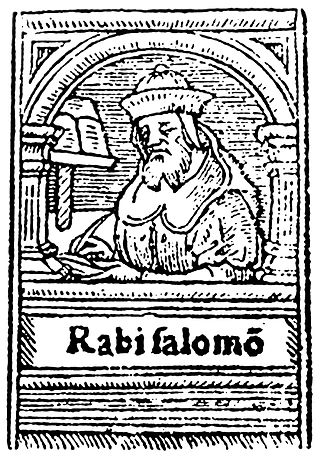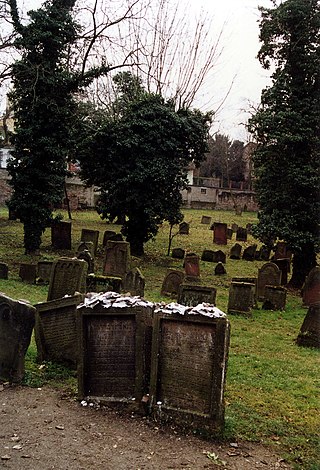Related Research Articles

Shlomo Yitzchaki, commonly known by the acronym Rashi, was a French rabbi who authored comprehensive commentaries on the Talmud and Hebrew Bible.
Asher ben Jehiel was an eminent rabbi and Talmudist best known for his abstract of Talmudic law. He is often referred to as Rabbenu Asher, “our Rabbi Asher” or by the Hebrew acronym for this title, the Rosh. His yahrzeit is on 9 Cheshvan.

Rabbinic literature, in its broadest sense, is the entire spectrum of works authored by rabbis throughout Jewish history. The term typically refers to literature from the Talmudic era, as opposed to medieval and modern rabbinic writings. It aligns with the Hebrew term Sifrut Chazal, which translates to “literature [of our] sages” and generally pertains only to the sages (Chazal) from the Talmudic period. This more specific sense of "Rabbinic literature"—referring to the Talmud, Midrashim, and related writings, but hardly ever to later texts—is how the term is generally intended when used in contemporary academic writing. The terms mefareshim and parshanim almost always refer to later, post-Talmudic writers of rabbinic glosses on Biblical and Talmudic texts.
Gershom ben Judah, best known as Rabbeinu Gershom and also commonly known to scholars of Rabbinic Judaism by the title Rabbeinu Gershom Me'Or Hagolah, was a famous Talmudist and Halakhist.
Jacob ben Meir, best known as Rabbeinu Tam, was one of the most renowned Ashkenazi Jewish rabbis and leading French Tosafists, a leading halakhic authority in his generation, and a grandson of Rashi. Known as "Rabbeinu", he acquired the Hebrew suffix "Tam" meaning straightforward; it was originally used in the Book of Genesis to describe his biblical namesake, Jacob.
Isaac ben Moses of Vienna, also called Isaac Or Zarua or the Riaz, is considered to be one of the prominent rabbis of the Middle Ages. He was probably born in Bohemia and lived between 1200 and 1270. He attained his fame in Vienna and his major work, the halachic guide known as the Or Zarua a compilation of halachic decisions and legal rulings, was very popular among Ashkenazic Jewry. He was a member of the Ashkenazi Hasidim and studied under many scholars, including Eliezer ben Joel HaLevi, Judah ben Samuel of Regensburg, Samson of Coucy and Eleazar of Worms. He was among the teachers of Meir of Rothenburg.

Meir of Rothenburg (c. 1215 – 2 May 1293) was a German Rabbi and poet, as well as a major contributing author of the tosafot on Rashi's commentary on the Talmud. He is also known as Meir ben Baruch, and by the Hebrew language acronym Maharam of Rothenburg. He was referred to by Rabbi Menachem Meiri as the "greatest Jewish leader of Zarfat " alive at the time.
Pilpul is a method of studying the Talmud through intense textual analysis in attempts to either explain conceptual differences between various halakhic rulings or to reconcile any apparent contradictions presented from various readings of different texts. The word pilpul has entered English as a colloquialism used by some to indicate extreme disputation or casuistic hairsplitting.

Joel ben Samuel Sirkis also known as the Bach, was a prominent Ashkenazi posek and halakhist, who lived in Central Europe and held rabbinical positions in Belz, Brest-Litovsk and Kraków, and is considered to be one of the greatest Talmudic scholars of Poland. He is known for his liberal rulings in his responsum in which he challenges the rabbinic status quo.
Mordechai ben Hillel HaKohen, also known as The Mordechai or, by some Sephardic scholars, as The Mordechie, was a 13th-century German rabbi and posek. His chief legal commentary on the Talmud, referred to as The Mordechai, is one of the sources of the Shulchan Aruch. He was killed in the Rintfleisch massacres in 1298.
Rabbi Jacob Pollak, son of Rabbi Joseph, was the founder of the Polish method of halakhic and Talmudic study known as the Pilpul.

Meir ben Izsak Eisenstadt was the author of responsa and other works of rabbinic literature. An authority on Halakha, he was consulted by rabbis from Turkey, Germany and Italy. He is known as the Panim Me'irot after his major work called Shu"t Panim Me'irot. He is also known as the Maharam Ash the Hebrew acronym for "Our Teacher, Rabbi Meir EisenStadt".
The history of responsa in Judaism, spans a period of 1,700 years. Rabbinic responsa constitute a special class of rabbinic literature, differing in form, but not necessarily in content, from Rabbinic commentaries devoted to the exegesis of the Bible, the Mishnah, the Talmud, and halakha. The codes themselves contain the rules for ordinary incidents of life. The responsa literature covers all these topics and more.

Yechiel Yaakov Weinberg (1884–1966) was an Ashkenazi Orthodox rabbi, posek and rosh yeshiva. He is best known as the author of the work of responsa Seridei Eish.
Simḥa ben Samuel of Speyer was a German rabbi and tosafist. Neither the year of his birth nor that of his death is known. He was one of the leading signatories of the Takkanot Shum He was a nephew of the director (parnas) Kalonymus, a student of R. Eliezer of Metz, and a colleague of Eliezer ben Joel ha-Levi.
Meir ben Isaac Katzenellenbogen was a German rabbi born in Katzenelnbogen.
Rashi's daughters were the three daughters and only children of the medieval Talmudic scholar, Rashi and his wife Rivka. Their three daughters were Yocheved, Miriam and Rachel. They each married their father's finest students and were the mothers of the leaders of the next generation of French Talmudic scholars. Almost every Ashkenazi rabbinic dynasty traces its ancestry back to either Yocheved or Miriam, and the majority of the tosafists, were recent descendants of Rashi's daughters. All born in Troyes, France, their descendants inhabited Germany, France, and Italy in the early 11th to 15th centuries, with the majority later moving to Eastern Europe, where they established several notable rabbinic dynasties.
In Jewish law, a posek is a legal scholar who determines the application of halakha, the Jewish religious laws derived from the written and Oral Torah, in cases of Jewish law where previous authorities are inconclusive, or in those situations where no clear halakhic precedent exists.
David Meir Frisch (c. 1812-April 25, 1882) was a 19th-century rabbinical authority.
References
![]() This article incorporates text from a publication now in the public domain : Singer, Isidore; et al., eds. (1901–1906). "AARON BEN MEIR OF BREST". The Jewish Encyclopedia . New York: Funk & Wagnalls.
This article incorporates text from a publication now in the public domain : Singer, Isidore; et al., eds. (1901–1906). "AARON BEN MEIR OF BREST". The Jewish Encyclopedia . New York: Funk & Wagnalls.